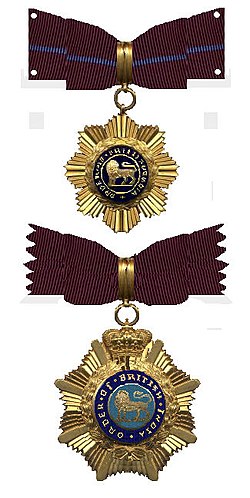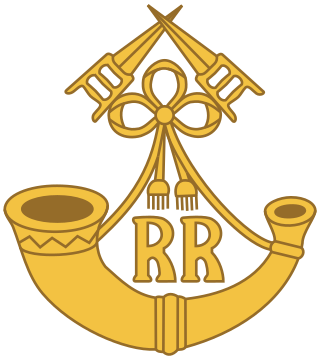
The Rajputana Rifles is the oldest rifle regiment of the Indian Army. It was originally a part of the British Indian Army, when six previously existing regiments were amalgamated to form six battalions of the 6th Rajputana Rifles. In 1945, the numeral designation was dropped from the title and in 1947 the regiment was transferred to the newly independent Indian Army. Since independence, the regiment has been involved in a number of conflicts against Pakistan, as well as contributing to the Custodian Force (India) in Korea under the aegis of the United Nations in 1953–54 and to the UN Mission to the Congo in 1962. As a rifle regiment, it uses a bugle horn as its insignia, the same as the British Light Division, but unlike its British counterparts, the Rajputana Rifles march at the same march pace used in the Indian Army as a whole.
Subedar is a military rank in the militaries of South Asia roughly equivalent to that of a warrant officer. Historically classes in the British Indian Army as a Viceroy's commissioned officer, the rank was retained in the Indian Army and Pakistan Army after independence. The rank of subedar is classed as a junior commissioned officer rank in India and Pakistan.
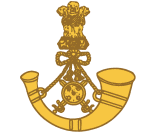
The Maratha Light Infantry is a light infantry regiment of the Indian Army. It traces its lineage to the Bombay Sepoys, raised in 1768, making it the most senior light infantry regiment in the Indian Army.

The Poona Horse is an armoured regiment in the Armoured Corps of the Indian Army. The regiment, known before independence as The Poona Horse, was raised as a regular cavalry regiment in the Bombay Presidency army of the East India Company. It was formed from the 3rd Regiment of Bombay Light Cavalry, raised in 1820, and the Poona Auxiliary Horse, raised about 1817–18. The latter unit was absorbed into the regular forces about 1860 and the two regiments later became the 33rd Queen Victoria's Own Light Cavalry and the 34th Prince Albert Victor's Own Poona Horse.

The Indian Order of Merit (IOM) was a military and civilian decoration of British India. It was established in 1837, although following the Partition of India in 1947 it was decided to discontinue the award and in 1954 a separate Indian honours system was developed, to act retrospectively to 1947. For a long period of time the IOM was the highest decoration that a native member of the British Indian Army could receive and initially it had three divisions. This was changed in 1911 when Indian servicemen became eligible for the Victoria Cross. A civilian division of the IOM also existed between 1902 and 1939, however, it was only conferred very rarely.

4th Horse (Hodson's Horse) is a part of the Armoured Corps of the Indian Army, which had its beginnings as an irregular cavalry regiment during the time of the Indian Rebellion of 1857.

Sardar Bahadur Risaldar Major Ganda Singh Datt, was a decorated soldier in the British Indian Army, who served in the 19th Regiment of Bengal Lancers.
Sardar Bahadur Risaldar Major and Honorary Captain Bakshi Tirath Ram Vaid, (1857–1924), also known as Tirath Ram, was a decorated soldier of the British Indian Army.
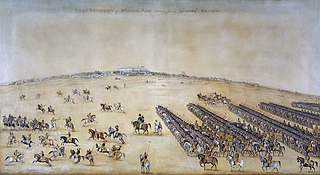
The 1st Horse (Skinner's Horse) is a regiment of the Armoured Corps of the Indian Army. It traces its origins as a cavalry regiment from the times of the East India Company, followed by its service in the British Indian Army and finally, after independence as the fourth oldest and one of the senior cavalry regiments of the Armoured Corps of the Indian Army.

The 2nd Lancers (Gardner's Horse) is one of the oldest and a highly decorated armoured regiment of the Indian Army. The regiment was formed by the amalgamation of two of the oldest regiments of the Bengal Army – the 2nd Royal Lancers (Gardner's Horse) and the 4th Cavalry.
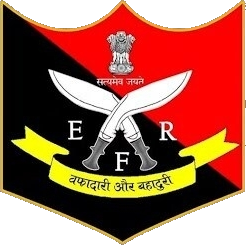
The Eastern Frontier Rifles (EFR) are a State Armed Police Force for the Indian state of West Bengal. They are a part of the West Bengal Police, as opposed to the Kolkata jurisdiction. The Border Guards Bangladesh are descended from the portion of the Eastern Frontier Rifles given to Pakistan during the partitioning of 1947.

The Deccan Horse or 9 Horse is one of the oldest and most decorated armoured regiments of the Indian Army. The Royal Deccan Horse , which was a regular cavalry regiment of the British Indian Army was formed from the amalgamation of two regiments after World War I. They saw service from the Mutiny of 1857 up to and including World War II.

The Central India Horse was a regular cavalry regiment of the British Indian Army and is presently part of the Indian Army Armoured Corps.

The Indian Distinguished Service Medal (IDSM) was a military decoration awarded by the British Empire to Indian citizens serving in the Indian armed forces and military police. When it was instituted in 1907 it was the second highest award available to Indians, behind the Indian Order of Merit (IOM). However, when eligibility for the Victoria Cross was extended to cover all Commonwealth subjects in 1911, the IDSM became third highest in the order of precedence. It was instituted in order to recognise acts of gallantry that did not meet the standards required of the IOM. The award was discontinued following the partition and subsequent independence of India in 1947.

Talagang is a city and the headquarters of the Talagang District located in Punjab, Pakistan. It is part of the Potohar Plateau and lies on the north of Salt Range and east of the Kala Chita range. Talagang is known for its literature and has produced prolific writers and poets including Dr. Satyapal Anand, who was born in 1931, in the adjoining village Kot Sarang. The area largely depends upon arid agriculture. It’s famous for its peanut production which is the highest in the Potohar region consisting of around 42,000 acres of cultivation followed by Chakwal, which has around 34,985 acres. It is known for its hunting grounds with local fauna including black francolin, white-throated francolin, quail, and hare.
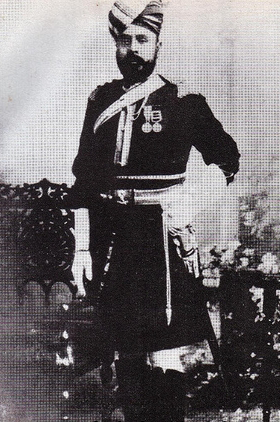
Risaldar-Major Mir Dad Khan, OBI, was from the Tareen tribe in Hazara region of the North West Frontier Province. He was a Risaldar Major in the British Indian Army. He was the father of former Pakistani president Ayub Khan and the Muslim League stalwart Sardar Bahadur Khan
The New Year Honours 1915 were appointments by King George V to various orders and honours to reward and highlight good works by members of the British Empire. They were announced on 1 January 1915.

Sardar Lehna Singh, Sardar Bahadur, (1825–1916) was a British Indian Army soldier and the Chief of the village Lehna Singhwala.

Captain Man Bahadur Rai AC, MC, IDSM was a highly decorated Indian Army Gorkha officer and a recipient of the Ashoka Chakra, the highest peacetime Indian gallantry decoration. Only the fourth Ashoka Chakra recipient to be decorated while living, he was the third Indian Army serviceman and the first Indian Army officer to have been honoured while alive.

Title Badges were presented to Indian citizens who received certain formal titles of honour during British rule in India. They ceased to be awarded in 1947 on Indian independence.
